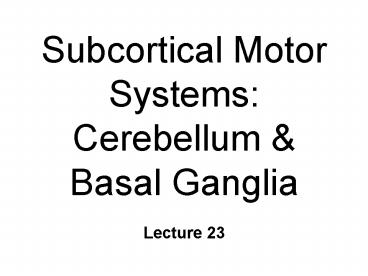Subcortical Motor Systems: Cerebellum PowerPoint PPT Presentation
1 / 36
Title: Subcortical Motor Systems: Cerebellum
1
Subcortical Motor SystemsCerebellum Basal
Ganglia
- Lecture 23
2
Motor Loops
- Cortex ---gt Subcortex ---gt Cortex ---gt Spinal
cord - Cerebellum
- coordination of movement
- Basal Ganglia
- selection initiation of voluntary movements
3
Cerebellum
- Also nonmotor functions
- memory/language
- Motor functions
- Coordination of movements
- Regulation of posture
- Indirect control
- Adjust outputs of descending tracts
4
Cerebellum
- Acts as comparator for movements
- compares intended to actual performance
- Correction of ongoing movements
- internal external feedback
- deviations from intended movement
5
Cerebellum
- Programs ballistic movements
- feed-forward control
- no feedback during execution
- direction, force, timing
- long term modification of circuits
- Motor learning
- shift from conscious ---gt unconscious
6
Cerebellum Anatomy
- Folia lobules
- analogous to sulci gyri
- Vermis - along midline
- output ---gt ventromedial pathway
- Hemispheres
- output ---gt lateral pathway
- Deep cerebellar nuclei
- fastigial, interposed, dentate
- Major output structures
7
Divisions Spinocerebellum
- Inputs
- spinal cord trigeminal nerve
- Outputs
- Motor execution
- From fastigial nuclei
- to medial descending tracts
- From interposed nuclei
- to lateral descending tracts
8
Divisions Cerebrocerebellum
- Inputs
- from Cortex pons
- Outputs
- Motor planning
- from dentate nuclei
- to motor premotor cortices
9
Divisions Vestibulocerebellum
- Inputs
- vestibular nuclei
- Outputs
- Eye movements body equilibrium
- to vestibular nuclei
10
I n t e r p o s e d
F a s t i g i a l
Dentate
11
Cerebellum 3 layered cortex
- Molecular layer
- parallel fibers
- axons of granule cells
- runs parallel to long axis of folium
- Purkinge cell layer
- large somas
- axons to underlying white matter
- perpendicular to main axis of folium
12
Cerebellum 3 layered cortex
- Granular layer
- innermost layer
- small, densely packed granule cells
- gt neurons in cerebral cortex
13
Cerebellum 3 layered cortex
Molecular
Purkinje
Granule
Mossy fibers
Climbing fibers
14
Cerebellum Motor Learning
- Purkinje cells only output from cerebellar cortex
- inhibit deep cerebellar nuclei
- Input to Purkinje cells
- Mossy fibers via parallel fibers
- from spinal cord brainstem nuclei
- climbing fibers
- cerebral cortex spinal cord
- via inferior olivary nucleus
15
Cerebellum Motor Learning
- 1 Purkinje cell synapses..
- 1 each with 200,000 parallel fibers
- Many with 1 climbing fiber
- strong synaptic connections
- Climbing fibers effects of mossy fibers
- transient
16
Cerebellum Motor Learning
- Long-term depression
- climbing parallel fibers active together
- in activity of specific Purkinje cells
- Climbing fibers may carry error signals
- corrections ---gt parallel fiber influence
- input specificity
- only affects active synapses of a parallel fiber
17
Motor Loop Through Cerebellum
- Lateral cerebellum
- simplest circuit
- 20 million axons
- Cortex ---gt pons cerebellum
- Prefrontal, Motor, PPC
- Pons Cerebellum ---gt thalamus
- VLc - ventrolateral nucleus
- VLc ---gt M1 ---gt lateral pathway
18
Lateral Cerebellar Motor Loop
Pons, Cerebellum
VLc
19
Cerebellum Damage
- Lesions ---gt no paralysis
- loss of motor coordination
- Dysynergia
- no simultaneous movement of joints
- serial movement only
- Dysmetric movements
- to wrong coordinates
- Alcohol intoxiction
- depression of cerebellar circuits
20
Basal Ganglia
- Many nonmotor functions
- memory other cognitive functions
- Indirect control of movement
- Selection Initiation of willed movement
- funnel cortical activation to SMA
- inhibition of inappropriate movement
21
Basal Ganglia
- Primary outputs
- prefrontal, M1, M2
- no direct outputs to spinal cord
- Primary inputs
- diverse regions of cortex
- no direct input from sensory receptors
22
Basal Ganglia
- Caudate nucleus
Putamen - Globus Pallidus
- Substantia Nigra
- tegmentum
- Subthalamic nucleus
- Control slow movements
23
Striatum
24
Cross section of Tegmentum
Substantia Nigra
25
Basal Ganglia Motor Loop
Basal Ganglia
VLo
26
Parkinsons Disease
- 1 of population
- Nigrostriatal pathway
- Substantia nigra neurons die
- Progressive loss
- Hypokinesia
- Rigidity
- Bradykinesia
- Akinesia
27
SMA
Cortex
Motor Loop
Putamen
VLo
Substantia Nigra
28
SMA
Cortex
Parkinsons Disease
Putamen
VLo
X
-
Substantia Nigra
29
Parkinsons Disease Treatment
- Basal Ganglia - Cholinergic
- Substantia Nigra - Dopaminergic
- Drug Therapy
- L-DOPA
- Pallidectomy
- Electrical stimulation of Globus pallidus
- Tissue transplants
30
Huntingtons Disease (Chorea)
- Rare
- onset 30-40s
- early as 20s
- Degeneration of Striatum
- Caudate
- Putamen
- GABA ACh neurons
31
Symptoms
- Khoros dance
- Uncontrollable, jerky movements
- dementia
- Progressive
- eventually fatal
32
SMA
Putamen
Huntingtons Disease
X
-
33
Huntingtons Disease Cause
- Genetic disorder
- Single dominant gene on chromosome 4
- HD mutation -
- unstable trinucleotide repeat - CAG
- of repeats correlated w/ age of onset
34
Huntingtons Disease Cause
- HD gene ---gt huntingtin
- 3 forms
- mutated form binds to protein
- involved in energy production
- neuron starves
- Excitotoxicity contributes to degeneration
- glutamate ---gt Nitric oxide (NO)
- Potential treatment Inhibit NO synthase
35
Hyperkinesia
- Excessive movement
- Ballism
- violent, flinging movements
- Lesions in subthalamus
- less inhibition of Vlo
- excitation of SMA
36
SMA
Striatum
Hyperkinesia (e.g. ballism)
-
X

